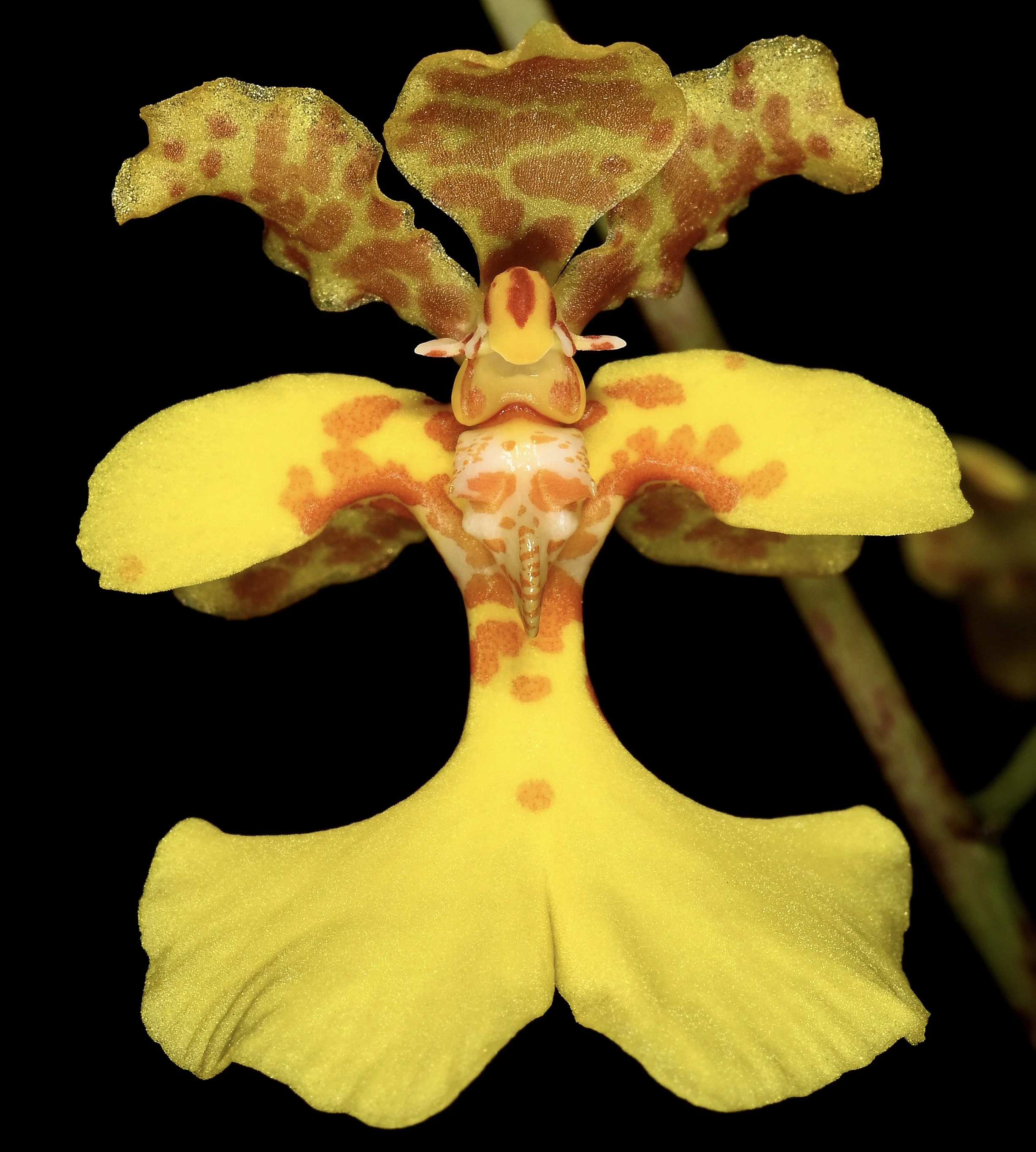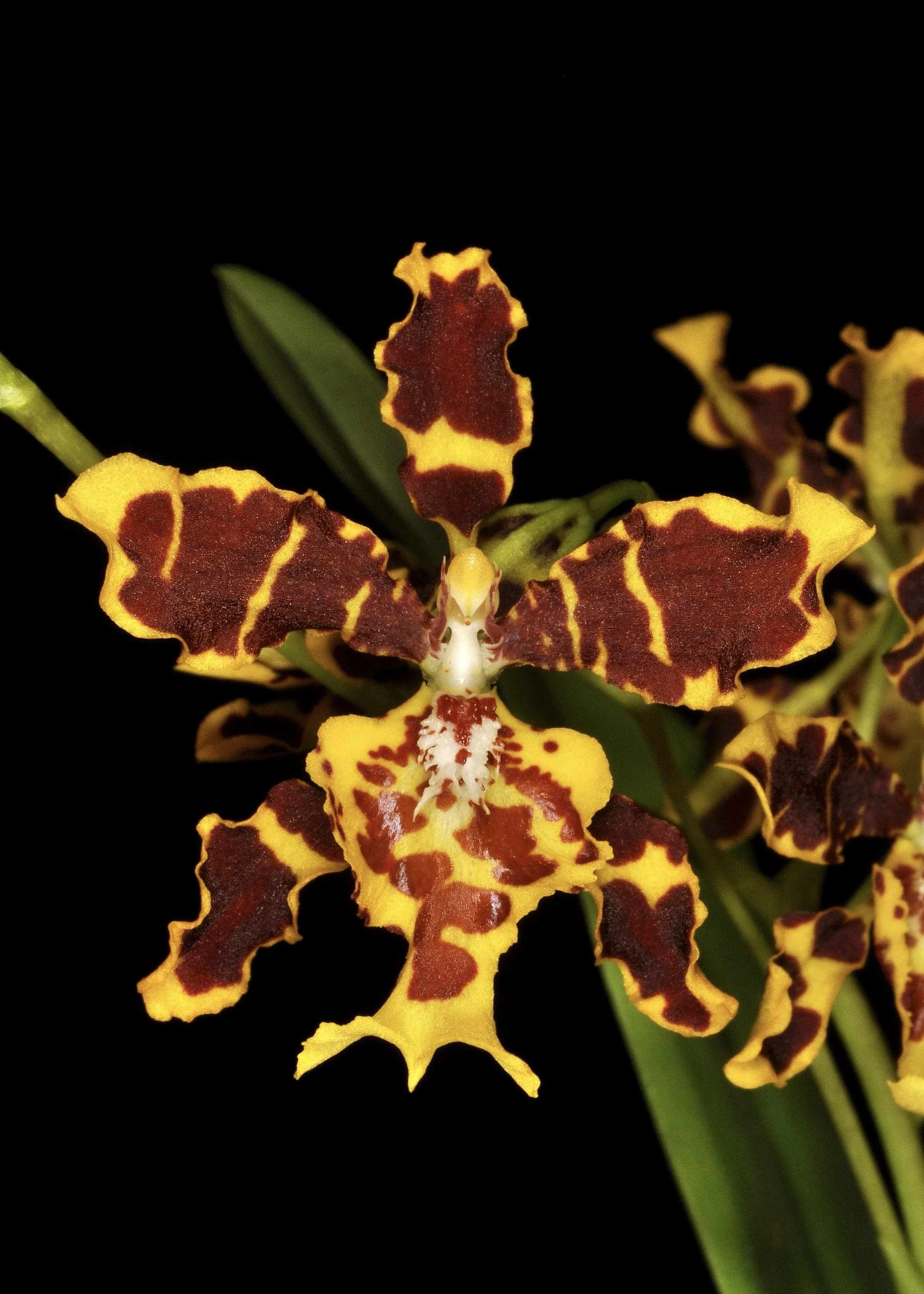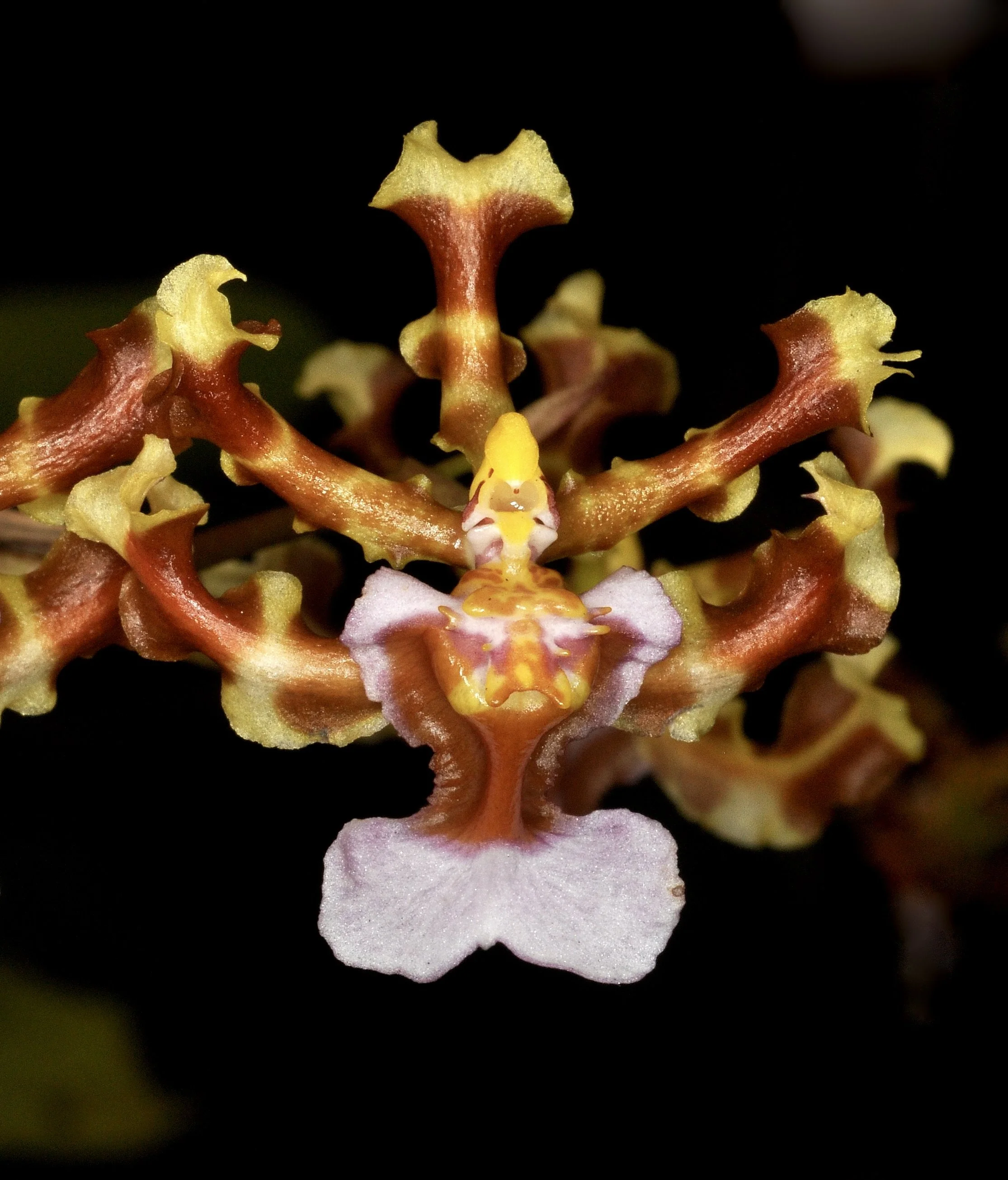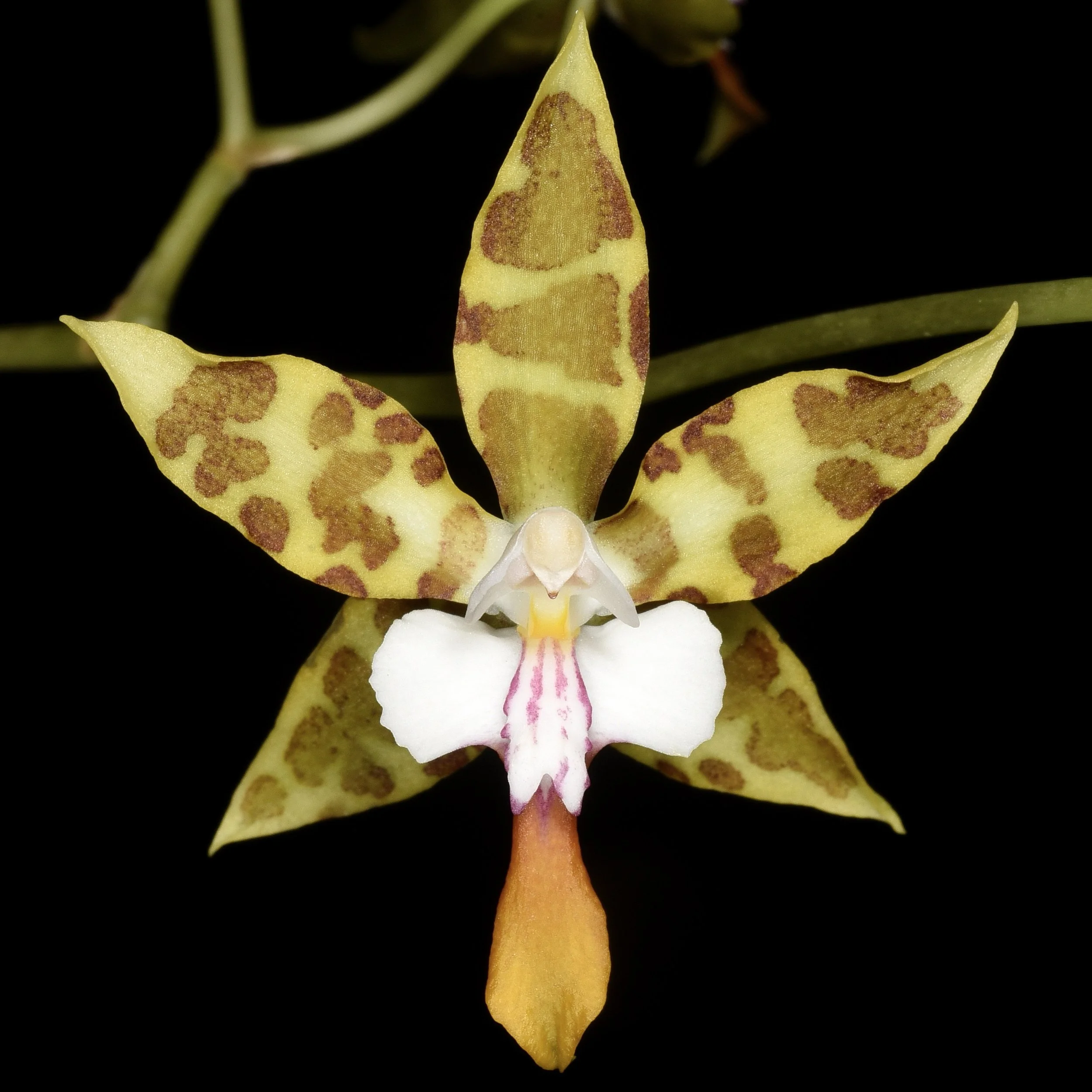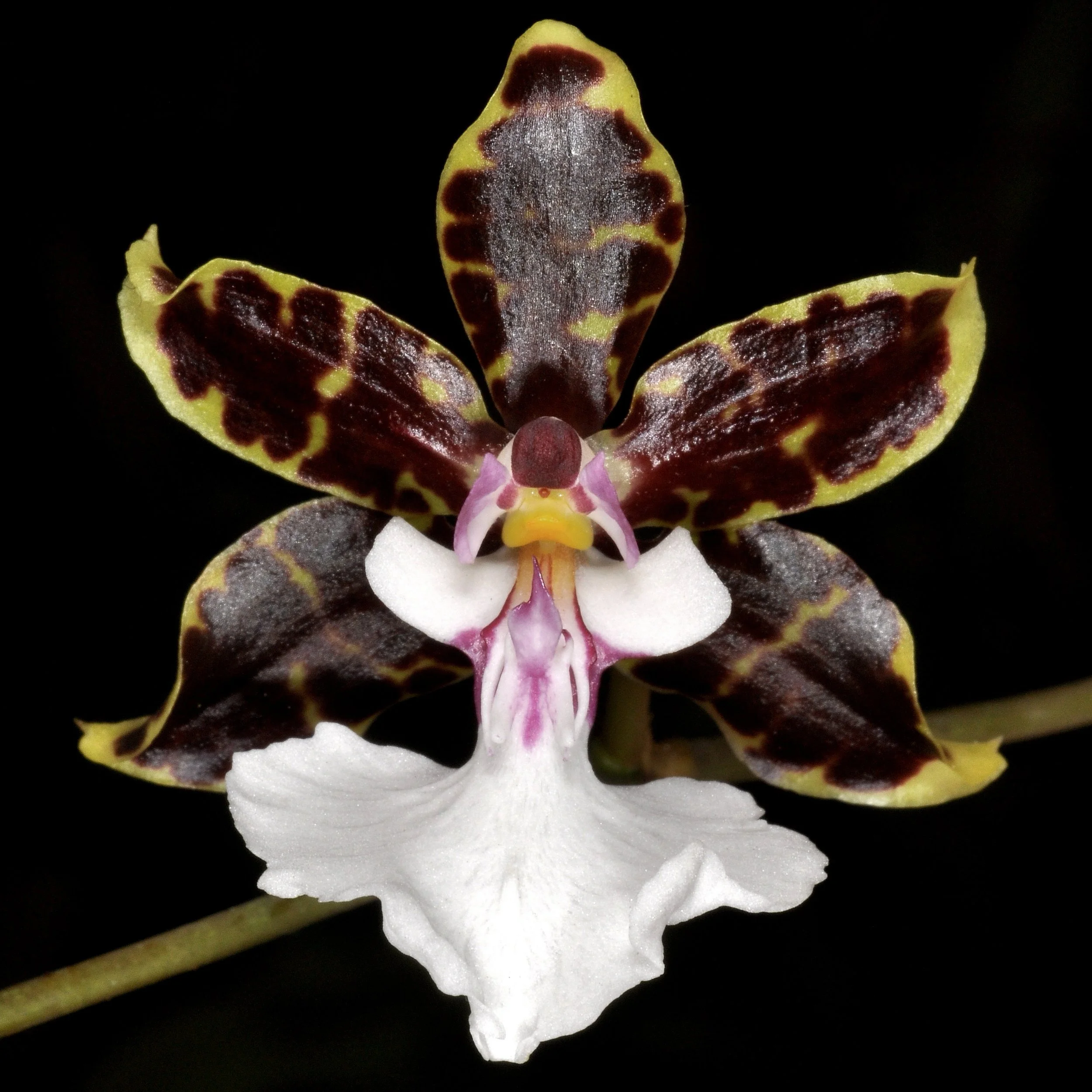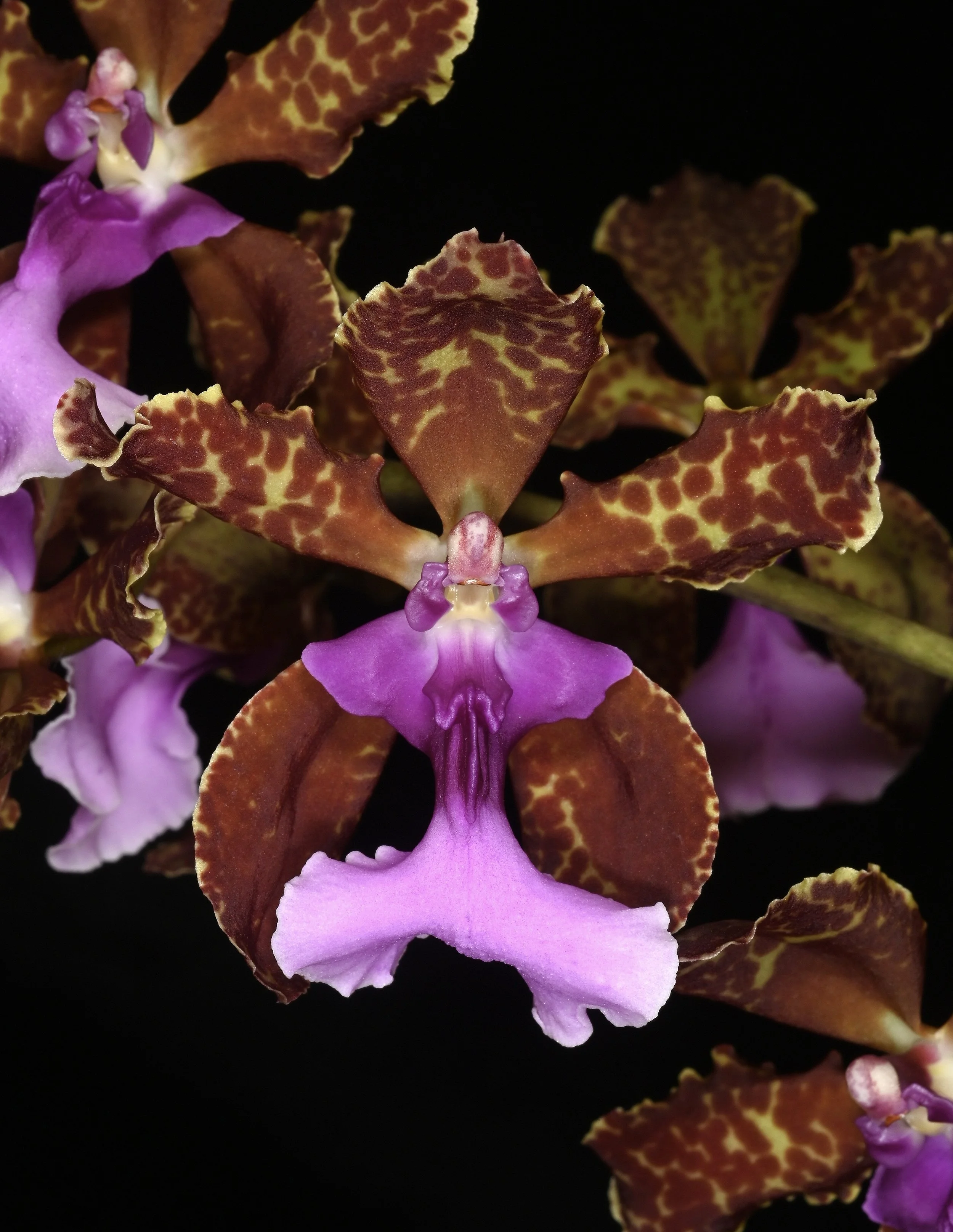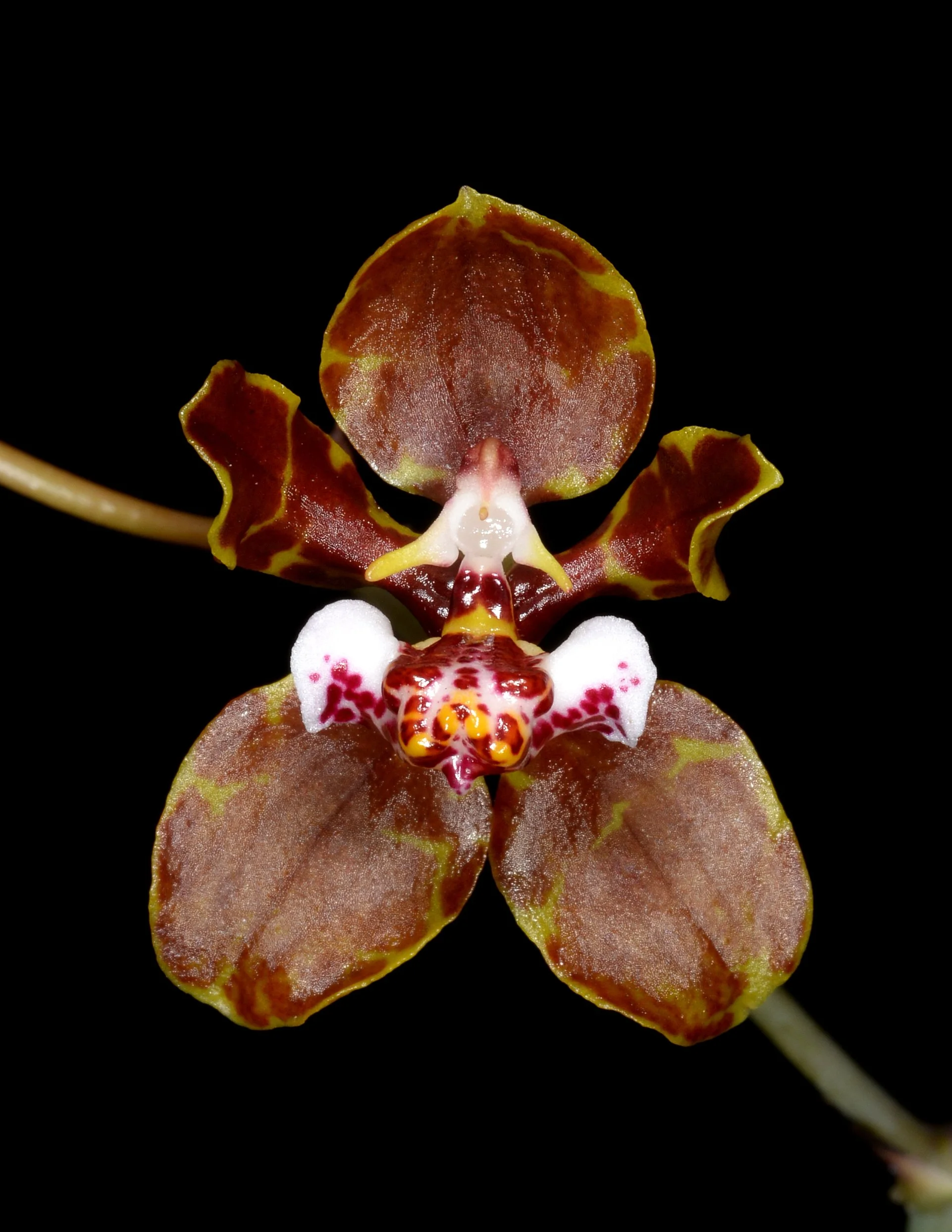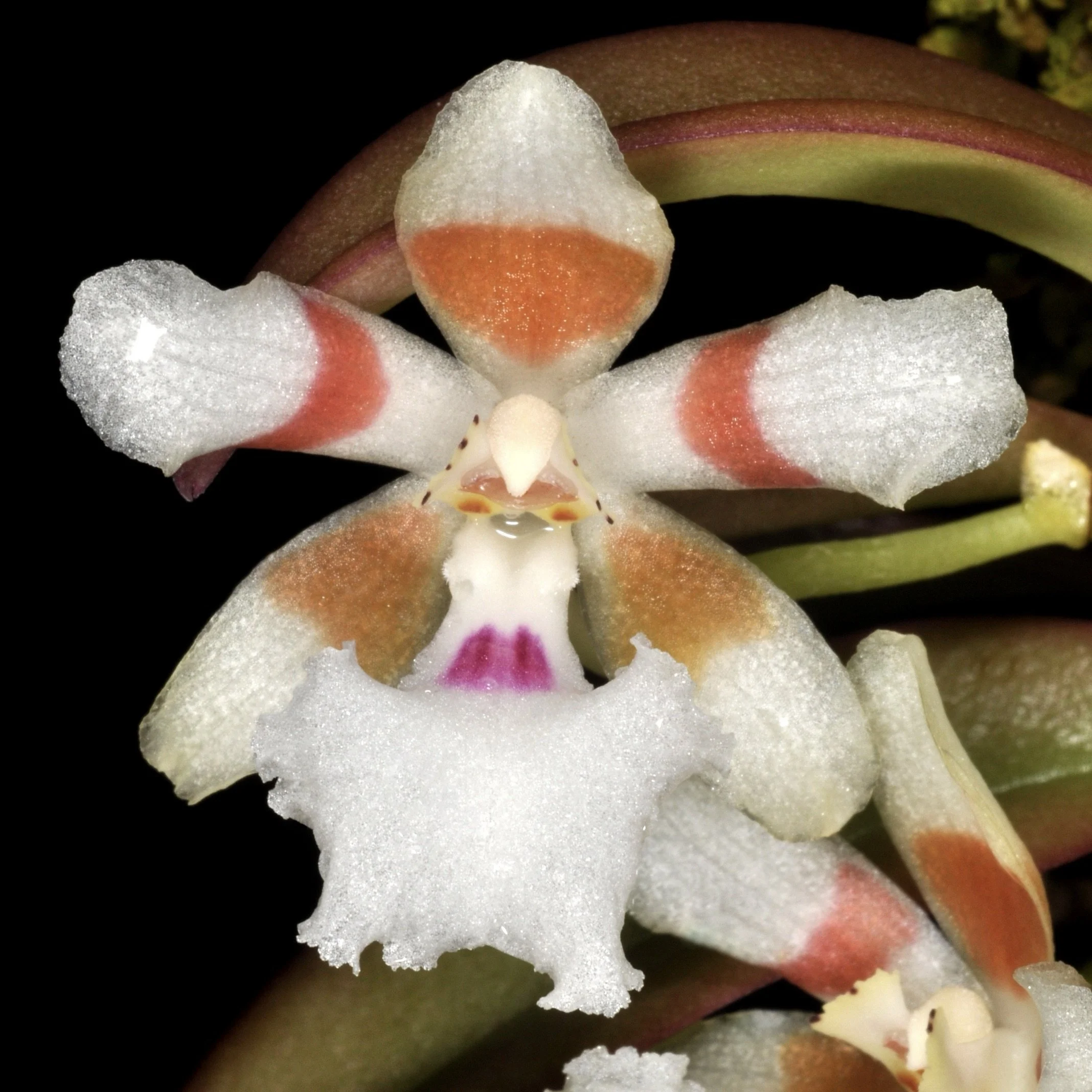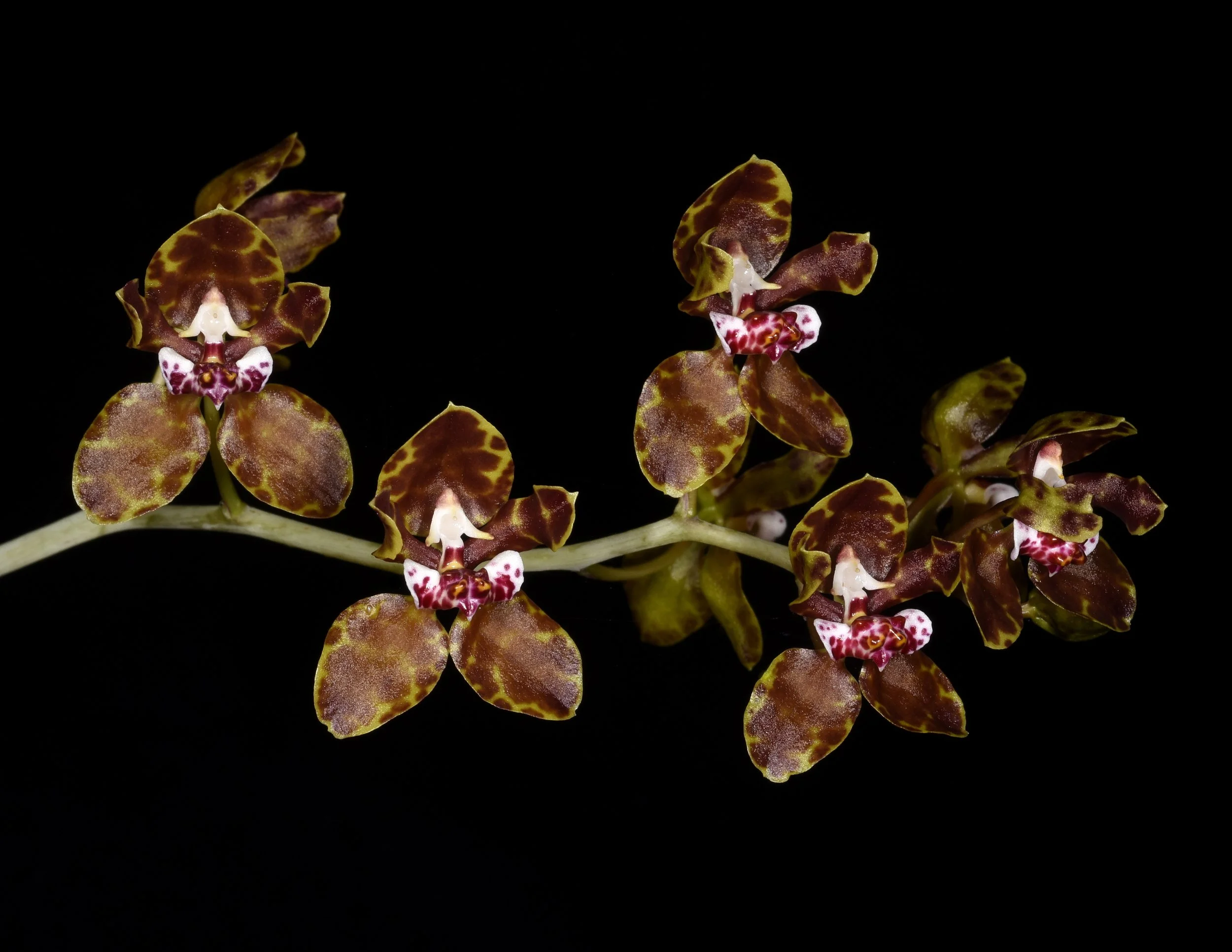The Serpents of Eden: A Seduction in Three Acts
Act I: Eyelash Vipers & Dancing Ladies
by William W. Lamar and Jay Vannini
Red-spotted yellow morph Central American Eyelash Pitviper, Bothriechis nigroadspersus, Costa Rica. Image: ©William W. Lamar 2024.
It’s fair to say that we all dream of Eden in one form or another at some point in our lives. Eden as a concept shapes literature, art, architecture, artificial landscapes, and even modern interiors.
Terrestrial Paradise in the classic, Book of Genesis sense contains three organic elements that many of us find irresistible: A beautiful and inquisitive woman, an endless garden filled with glorious flora, and an interesting and dangerous snake.
We’ll deal with a pair of these beings in this post and again in other related articles planned for 2025.
Readers who are not herpetologically-inclined may find it surprising that some of the world’s most colorful animals include venomous snakes. Besides New World and south Asian coralsnakes (Elapidae: Micrurus, Micruroides, Leptomicrurus, and Calliophis species), arboreal tropical pitvipers (Viperidae: Crotalinae; Bothriechis, Bothrops [incl. Bothriopsis], Craspedocephalus, Trimeresurus, and Tropidolaemus species), and African bush vipers (Viperidae: Viperinae; Atheris species) contain dozens of species whose splendid, improbable colors and skin patterns test the credulity of the viewer and rival even the most showy tropical birds, poison frogs, and coral reef fish in terms of visual impact.
This article deals with a group of relatively small arboreal Neotropical pitviper species commonly referred to as eyelash vipers (our preferred shorthand), eyelash pitvipers, or eyelash palm-pitvipers. Specifically, we will focus on one wide-ranging form that occurs from low and middle elevation humid and wet forests from southeastern Mexico in Chiapas and Tabasco States, throughout Central America (excepting El Salvador), across the Panamanian border and into Colombia’s Chocó Department. Long misidentified as Bothriechis schlegelii (Bocourt), which is now recognized to be a Colombian highland endemic, it has recently been correctly assigned to B. nigroadspersus Steindachner. It is one of the best known Mesoamerican and Panamanian snake species and is, together with its ecological equivalent in Central- and western tropical Africa, the Variable Bush Viper (Atheris squamigera), the most variably colored snake species of all. In some notable forms from the Caribbean slopes of Costa Rica and western Panamá, the snakes’ ground color is a vibrant yellow or pale orange, often peppered with green, red, and black spots or blotches. These morphs are known in the region as oropel (= Fool’s Gold) and are generally believed by rural folk to be a distinct species from the more common color variants with brown or green ground colors.
Shown above, eyelash pitvipers have visually similar Old World parallels among the arboreal African bush vipers. Above left, yellow and green morph Variable Bush Viper, Atheris squamigera, and right, a tiger-striped Central American Eyelash Pitviper, Bothriechis nigroadspersus. Images: ©William W. Lamar 2024
A remarkable example of an eyelash pitviper lookalike in Malesia is the insular Mcgregor’s Pitviper (Trimeresurus mcgregori) from Batanes Province in the Philippines. This handsome and Endangered snake is a textbook case of convergent evolution and shares several color morphs with Bothriechis nigroadspersus, especially the yellow forms.
Central American Eyelash Pitvipers range across the color spectrum from off-white to near black, with every hue and shade combination in between (other than true blue) popping up throughout the central and southern parts of their range. Snakes inhabiting the northern end of their distribution in southeastern Mexico and northern Guatemala tend to be more soberly clad and uniform in appearance than Costa Rican and Panamanian examples. This is especially so when comparing with the populations of Bothriechis nigroadspersus occurring in Limón Province in the former country, and the eastern lowlands of Ngäbe-Bugle and Bocas del Toro Province in the latter.
Green and orange form Bothriechis nigroadspersus, Costa Rica. Image: ©William W. Lamar 2024.
Eyelash pitvipers share their subcanopy homes with an incredibly diverse flora that includes many of Central America’s most showy-flowered epiphytic orchids. One of the largest subtribes native to the region is the Oncidiinae, with some genera commonly known as Dancing Doll or Dancing Lady Orchids. A few large-growing lowland species that produce massive sprays of small yellow and brown flowers (e.g., Oncidium sphacelatum) were formerly known as Golden Showers.
Alas, since this common name is considered a bit racy and controversial nowadays it has fallen into disfavor among many orchid aficionados.
Given their striking (excuse the pun) appearance, the internet is laced with images–including many extremely good ones–of outrageous Central American Eyelash Pitviper color morphs. Rather than just adding more noise, we thought that combining some of the many chromatic variants with largely sympatric oncidiine orchids of similar shades would be a creative and illustrative way to pair these organisms that emphasizes synchronicity of color and form in their native ecosystems.
Note that arboreal Neotropical pitvipers are often associated with understory plants with phytotelmata growing near or along streams such as heliconias, large aroids, tank bromeliads, together with arborescent pipers, melastomes, tree ferns, and palms. It would be quite unusual to say the least to actually find one of these snakes perched on a flowering orchid in nature. But they certainly share their forested neighborhoods with many of these plants, and one might argue that their colors and patterns are cryptic in nature. That is, they afford some degree of protection to their owners in that they disguise the snakes from potential predators.
It is important to understand that other animals–including prey, predators, and pollinators–see both the pitvipers and the orchid flowers shown here very differently than we do. What are the environmental forces that generate brilliant yellow, orange, and red snakes and how do they appear under different light spectra visible to non-humans? It is both tempting to speculate on and worth evaluating the lengthy and complex evolutionary processes that generate these fabulous animals and plants and the megadiverse ecosystems they inhabit. Persuasive (and possibly correct) theories notwithstanding, it is also possible this diversity of colors and patterns exists simply because there are no selective pressures weeding out the continual, random mutations that occur in nature.
Enjoy, folks.
Left, yellow and pale orange morph Bothriechis nigroadspersus, Costa Rica. Image: ©William W. Lamar 2024. Right, Trichocentrum ascendens (Lindl.) M. W. Chase & N. H. Williams – Mexico to Bolivia. Image: ©Ron Parsons 2024.
Left, red and orange morph Bothriechis nigroadspersus, Costa Rica. Image: ©William W. Lamar 2024. Right, Oncidium anthocrene Rchb. f. – Panama and Colombia. Image: ©Ron Parsons 2024.
Left, red-blotched yellow morph Bothriechis nigroadspersus, Costa Rica. Image: ©William W. Lamar. Right, Trichocentrum silverarum (Carnevali & Cetzal) J. M. Shaw – Panama. Image: ©Ron Parsons 2024.
Right, Bothriechis nigroadspersus, Limón Province, Costa Rica. Image ©Louis W. Porras 2024. Right, Oncidium zelenkoanum Dressler & Pupulin – Panama. Image: ©Ron Parsons 2024.
Left, yellow and orange morph Bothriechis nigroadspersus, Costa Rica. Image: ©William W. Lamar. Right, Oncidium maduroi Dressler – Panama. Image: ©Ron Parsons 2024.
Left, typically colored, lichen green and orange-blotched Bothriechis nigroadspersus, Costa Rica. Image: ©William W. Lamar 2024. Right, Oncidium hastatum (Bateman) Lindl. – Mexico and Guatemala. Image: ©Ron Parsons 2024.
Left, orange morph Bothriechis nigroadspersus. Image: ©William W. Lamar 2024. Right, Trichocentrum andraeanum (Cogn.) R. Jiménez & Carnevali - Mexico and Guatemala. Image: ©Ron Parsons 2024.
Left, Blotched Eyelash Pitviper, Bothriechis supraciliaris, Costa Rica. ©William W. Lamar 2024. Right, Oncidium leucochilum Bateman ex Lindl. – Mexico to Honduras. Image: ©Ron Parsons 2024
Other Common Names
Vernacular names, often descriptive, lurid, and compelling, also reflect the cultural impact of an animal. The Eyelash Pitviper has figured prominently in our world since ancient times and has existed alongside many native peoples in the region ever since man’s arrival in northern Mesoamerica. The diversity of common names applied to these snakes illustrates how well-known/notorious they are among local residents. Inasmuch as the species complex has been recently revised, some of the names below may prove to apply to closely allied forms. And we suspect there will be more revisions affecting Middle American populations in the future. However, human migrations within countries (such as Colombia) have resulted in an especially rich local mix of common names, so we have found it useful to pay attention to all of them.
Herewith, a gallery of local common names used across their range.
Belize: green tommygoff. Colombia: birrí, bocaracá, colgadora, dormilona, flecha, guaruma, jerga, manzanilla, mortiñera, muerde-hojas, pató (Urrao, Antioquia Department), patoco de pestaña, patuta, pauta víbora, pestañosa, piri, pudridora, siete tiros, tiro, toboba de pestaña, veinticuatro, víbora, víbora cabeza de candado, víbora granadilla, víbora grana de oro, yaruma (Chocó Department). Costa Rica, Nicaragua, and Panama: bocaracá, culebra de cachitos, oropel, sleeping gough, terciopelo de pestaña, toboba de pestañas, toboba. Ecuador: cordoncillo amarillo (yellow color phase), cuchuli, lora, ohuedo piní (Colorado tribe), papagayo, sura. Guatemala: Chaj B’olay (Ch’ol Maya = thin spotted one or thin jaguar), víbora de árbol. Honduras: dormilona, dus-pyutka, lucerito, pestañuda, pyutka carretilla, víbora amarilla, víbora de pestañas, waba, yema de huevo (yellow color phase). Mexico: nauyaca cornuda, nauyaca de pestañas.
Pale form of Bothriechis nigroadspersus. Image: ©William W. Lamar 2024.
Yellow and pale orange morph Bothriechis nigroadspersus. Image: ©William W. Lamar 2024.
Left, juvenile Bothriechis nigroadspersus at Castillo de la Fortuna, Alajuela Province, Costa Rica. ©William W. Lamar 2024. Right, Trichocentrum lanceanum (Lindl) M. W. Chase & N. H. Williams – Colombia to Bolivia. Image: ©Ron Parsons 2024.
Left, red and black-spotted yellow morph Bothriechis nigroadspersus. Image: ©William W. Lamar 2024. Right, Erycina crista-galli (Rchb. f.) N. H. Williams & M. W. Chase – Mexico to Peru. Image: ©Jay Vannini 2024.
Left, dark, richly-colored morph Bothriechis nigroadspersus, Costa Rica. Image: ©William W. Lamar. Right, Trichocentrum microchilum (Batemam ex Lindl.) M. W. Chase & N. H. Williams – Mexico to Honduras. Image: ©Ron Parsons 2024.
Left, varicolored Bothriechis nigroadspersus, Punta Cocles, Limón Province, Costa Rica. Image: ©William W. Lamar 2024. Right, Trichocentrum pfavii Rchb. f. - Costa Rica. Image: ©Ron Parsons 2024.
Pure yellow morph Bothriechis nigroadspersus - Costa Rica. Image: ©William W. Lamar 2024.
“Wheresoever she was, there was Eden.”
In-situ In-Eden
A selection of color variants of the Central American Eyelash Viper, Bothriechis nigroadspersus, photographed in lowland rainforest on both coasts of Costa Rica. All images: ©William W. Lamar 2024.
Upper left, open mouth threat display at Guayacán, Limón Province. Upper right, pale brown morph also photographed at Guayacán, Limón Province.
Middle left, Fortuna de San Carlos, Alajuela Province. Middle right, Limón Province.
Lower left, Punta Marenco, Puntarenas Province. Lower right, La Gamba, Puntarenas Province.
Two specimens currently matching the description of Bothriechis “nitidus”, a southern member of the eyelash viper species complex. Left, a juvenile from the Tandayapa Valley, Pichincha Province, Ecuador. Right, a mature example from Esmeraldas Province, Ecuador. Images: ©William W. Lamar 2024.
Trichocentrum microchilum (Bateman ex Lindl.) M. W. Chase & N. H. Williams. Mexico to Honduras. Image: ©Ron Parsons 2024.
Green and white form Bothriechis nigroadspersus, Costa Rica. Image: ©William W. Lamar 2024.
Warning: For those unwary or reckless ecotourists and nature photographers who may be inclined to press their luck while taking close-closeup stills or video of eyelash pitvipers in nature or regional reptile parks, we will only say that you do so at your own risk. While temptingly beautiful and photogenic refugees from Paradise Lost, never get your hands nor face in close proximity to these animals unless there is glass or rigid plastic in between. All species of pitvipers can (and will!) inflict painful and dangerously venomous bites when crowded or touched. While you may not roll over and die immediately if tagged by one, for a few hours at least you may very well wish that you had.
Please use common sense and an abundance of caution when engaging any venomous snake in nature!
Left, red and black spotted yellow morph Bothriechis nigroadspersus. Image: ©William W. Lamar. Right, Trichocentrum cebolleta (Jacq.) M. W. Chase & Williams – Mexico to Bolivia. Image: ©Ron Parsons 2024.
Acknowledgements
Many thanks to the anonymous private collectors in the U.S. who generously provided their captive animals and cultivated plants as models for many of the images shown here. In Costa Rica, Louis Porras, Mahmood Sasa, and Alejandro Solórzano provided live specimens and excellent companionship in the field. Renowned wild plant photographer, friend, and frequent collaborator Ron Parsons very kindly let us sift through his inventory of hundreds of stunning photos of Central American Oncidiinae to select those that provided attractive visual foils for the snakes. Louis Porras also chipped in his well-known image of an unusually-colored Tico Bothriechis nigroadspersus that will be instantly recognized by herpetologists and herpetoculturists who are up to speed on contemporary regional reference literature.
¡Mil gracias a todos!
All content ©Exotica Esoterica LLC®, 2024, ©William W. Lamar, 2024, ©Ron Parsons, 2024, ©Louis W. Porras, 2024, and ©Jay Vannini, 2024.
Typical color form observed in Bothriechis nigroadspersus from the northern extension of its range. Lower Motagua Valley, Izabal Department, Guatemala. Some wild examples from this region can attain exceptionally large size (>40”/103 cm) for this species. Image: ©William W. Lamar 2024
A giant Golden Shower Orchid, Oncidium sphacelatum, with a 10’/3.1 m span in nature north of Chisec, Alta Verapaz, Guatemala. Central American Eyelash Pitvipers have been observed and collected in this area, which is located adjacent the Mexican border and its Lacandón rainforest in Chiapas State. Image: ©Jay Vannini 2024.
Follow us on:





